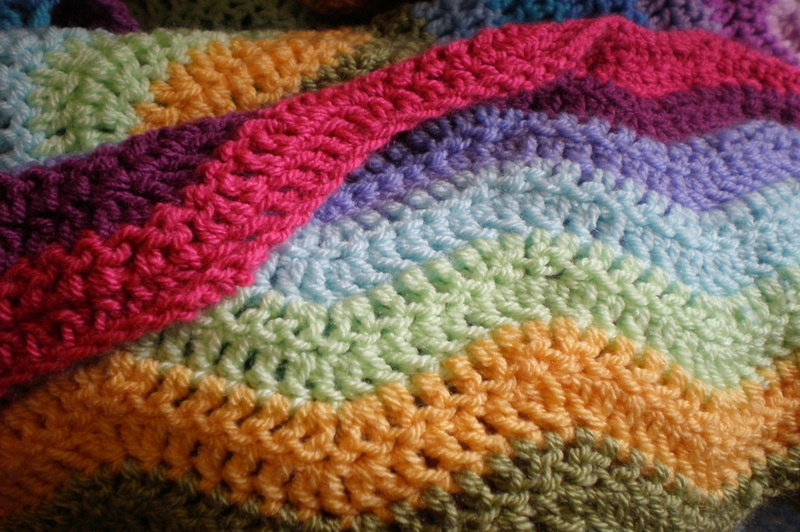Knowing how to block a large crochet blanket you made would save the beautiful work you dedicated the last few days on.

Blocking your crochet blanket isn’t that hard either, as it only involves using pins to set it in place, a blocking mat, and some water to dampen it.
A blocked crochet blanket looks more professional. Blocking helps in shaping it and evening out the tension all over the product. However, choosing your method of blocking needs more forethought.
Using a random method of blocking could ruin your piece if you’re not careful. Read on so you can find out which way would work best for you!
How To Block A Large Crochet Blanket Properly
Spray blocking
Spray (or cold) blocking is the simplest way of blocking a crochet piece. All you need is a towel or blocking mat and a spray bottle.
- Step #1. Lay your towel or blocking mat flat on a table. For a larger piece, you might need multiple towels or mats.
- Step #2. Place the blanket on top of the towel and lay it out the way you want it to look. Afterward, pin the blanket’s corners onto the towel and place a pin every two to three inches on the edges to lock it in place.
- Step #3. Spray the blanket evenly with water, just enough to dampen it. All that is left to do is to let it air dry, which could take up to two hours.
- Step #4. To speed up the process, you can point a fan at the blanket.
Wet blocking
Wet blocking involves water, just like the spray method. However, instead of spraying, you have to dip the entire blanket in water.
- Step #1. Fill up a clean tub with water and dip your crochet blanket in it. Let it sit in the water for up to 10 minutes, ensuring that the fibers have soaked up water completely and have relaxed.
- Step #2. After 10 minutes, pull the blanket out of the water and place it on multiple pieces of cloth or towels. Take another towel and put it on top of the blanket.
This process is necessary to remove the excess water, which would also speed up the drying process. Under all circumstances, do not wring your blanket, or else you risk damaging the yarn.
- Step #3. After getting all the excess water out, place your blanket on dry towels or blocking mats and spread it out flat. Pin the corners of the blanket, and put one pin every 2 to 3 inches at the edge. Let it sit and air dry.
The drying process takes a few hours. It could be longer or shorter than the first method depending on how much of the excess water you got out.
Steam blocking
Unlike the first two methods, steam blocking uses another tool: either a garment steamer or an iron on the steam settings.
- Step #1. Do not put the iron or the garment steamer directly onto the blanket because the intense heat could destroy your delicate project. Instead, have it hover above the blanket at a distance of around one to three inches.
- Step #2. Place your blanket onto a towel or a blocking mat. Pin the blanket onto the towel or mat and place a pin at every 2 to 3 inches on the edges.
- Step #3. Using the iron or the garment steamer, hover all over the blanket to dampen it. Hover around an area for two to three seconds before moving on to the next part of the blanket.
- Step #4. Stretch out the bumps and the wrinkles carefully, making sure not to pull too hard. If you pull too hard on your blanket, it might loosen your stitches.
- Step #5. Afterward, all that is left is to dry the blanket. Since you used steam, the drying process could take about 30 minutes to an hour.
How Do You Choose Which Method To Use?
Choosing which method to use depends on the material used for the crochet. Using the steam method on delicate yarn, for example, could potentially damage the blanket.
Natural fibers like wool, alpaca, and cotton can be blocked using the spray method or the wet method. Blocking these fibers would make them bloom and fill in the gaps of the stitches.
For acrylic yarn, blocking with water may not be ideal because the acrylic yarn does not soak up water. You can choose to use the steam method for it.
Though blocking for acrylic yarn isn’t permanent, we recommend that you do it anyway because the result would look neater.
For silk, blocking needs a lot of care. It is because the material is too fragile and cannot withstand too much water or heat.
If you have doubts about the material you are using, you could check the washing instructions that come with the yarn.
If your yarn or fiber does not have instructions, then it is recommended to create a swatch. A swatch is like a smaller version of your project. It is better to damage your swatch than to damage your 40-hour crochet blanket!
Conclusion
Crocheting is an art form that is time-consuming and tedious but very rewarding. With it, you can create large blankets or even clothes for your loved ones.
However, crocheting is a delicate art. Knowing how to block a large crochet blanket properly could save you all the trouble of redoing it. Remove the risk and stress of having your hard work suddenly shrink before your eyes by following the easy methods above.
